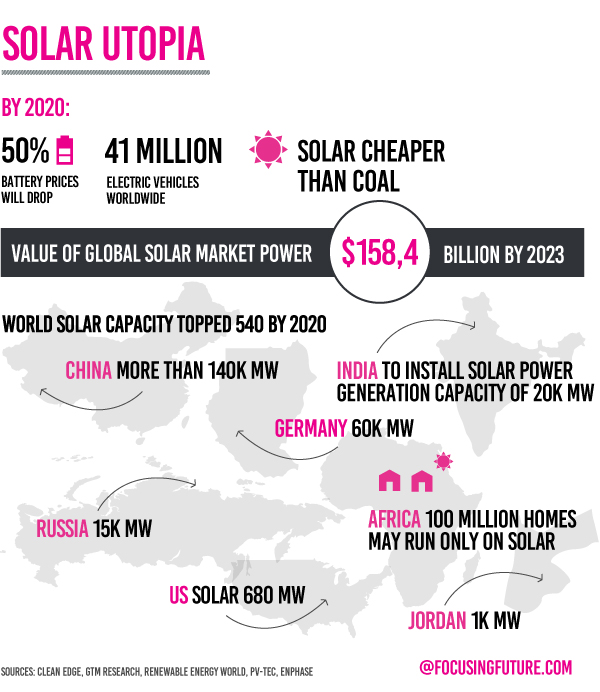![]() 4 minute read
4 minute read
It can never be said too much of the energy provision of the future. Sustainable development demands the breakthrough, or “miracles” as Bill Gates calls it. Can Tesla and SolarCity merge satisfy the demand? And how Chile made its electricity zero-carbon, and even free?
Marrying
solar sustainability
Elon Musk is determined to make his dreams come true. Not only he is making the SpaceX possible and testing new vacuum train in California but also he goes forward with the full solar ecosystem. On 20th of June, Tesla Motors have made an offer to acquire the SolarCity company. The SolarCity is leading USA company of solar power solutions for houses and businesses. Companies have overlapping directorships and share the vision of[nbsp]accelerating “the world’s transition to sustainable energy”. Besides, there is a long cooperation between and numerous joint projects. It is argued that the merger will trigger the generation of innovative solutions for sustainable transportation and energy converting Tesla from automotive to energy company.
Combining the knowledge and insight of Tesla Motors and SolalCity, the future of solar powered eco city might be not as distant as predicted. Already today, by some expectations, there will be up to 41 million electric vehicles in the world in 2020. By that time the dependence on the fossil fuels is expected to decrease significantly. Undoubtfully, Elon Musk is ready to make his dream truth, even those of them, which seems to be extremely futuristic.

While Elon Musk is actively moving forward with his dreams, world sees that the world will change under pressure of innovation. A sustainable world with no fossil fuel dependence and a zero-carbon footprint is a reality in nearest future. Major forward-looking companies join Tesla’s lead transitioning their ecosystem toward efficient and energy friendly existence. Same goes for country policies and international agreements. Let’s see how others succeed in transforming their economy to the solar utopia.
Chile’s
solar surplus
Chile found the way to deal with the increase in energy demand, triggered by flourishing mining production and economic growth. Moreover, the country aims for zero-carbon energy provision utilizing the benefits of sunny geographical location. As the result, there are 29 solar farms with another 15 planned.
In 2016, the surplus in the energy production from solar plants resulted in spot prices reaching zero for more than hundred days in Chile. Bloomberg reports that the solar power in the central grid has quadrupled since 2013. While having free energy sounds like a dream for residents, investors account for losses. Salvator Bernabei, head of Enel Green Power SpA’s operations in Chile, says that the rapid development of renewables came as a surprise. The solutions have to come soon as low prices will disturb companies that have own power plants.
The answer lays in the solving the infrastructure problem. Chile has two disconnected grids – central and northern, which does not allow to transfer the excess energy to the whole country. Therefore, the government is planning to build a 3,000-kilometer long transmission line by 2017.
Solar
infrastructure
“Roads spend 90 percent of their time just looking up into the sky. When the sun shines, they are of course exposed to its rays,” says manager of the Center for Expertise at the Colas Campus for Science and Techniques, Jean-Lic Gautier, “It’s an ideal surface area for energy applications.”
Dream of the solar, ecological, modern city is on the way to be accomplished. US, Netherlands and France employ the solar panel as motorways, parking lots, and pedestrian paths. As any innovation, the solar roads have many skeptics. Nevertheless, the idea is contributing to the Elon Musk’s future vision.
There have been much said of the solar road in Netherlands, now French innovation steps forward. France plans to build “Wattway” – 1,000 km long solar road by 2017. The project is a collaboration between Colas, a transport infrastructure company, and INES (France’s National Institute for Solar Energy), and sanctioned by France’s Agency of Environment and Energy Management. The solar panels are made of reused glass and can be installed straight on the pavement. Made out of polycrystalline silicon, the panels are only 7mm thick and are resistant to rain and snow. The efficiency of the road is expected to power up to 5,000 households. Producers claim that Wattway has a 15 percent yield, which is only 3-4 percent less than in conventional photovoltaic panels.




